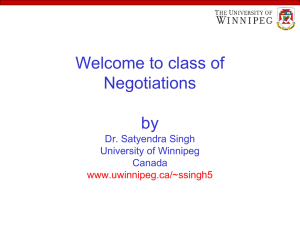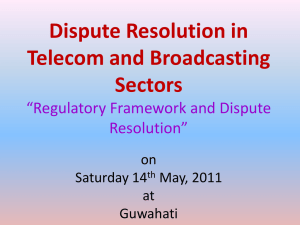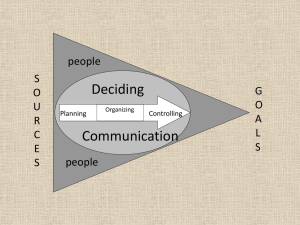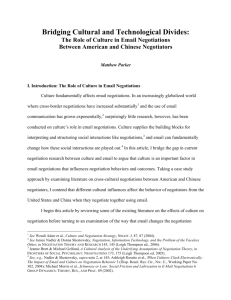Session 27 - Art of negotiation
advertisement
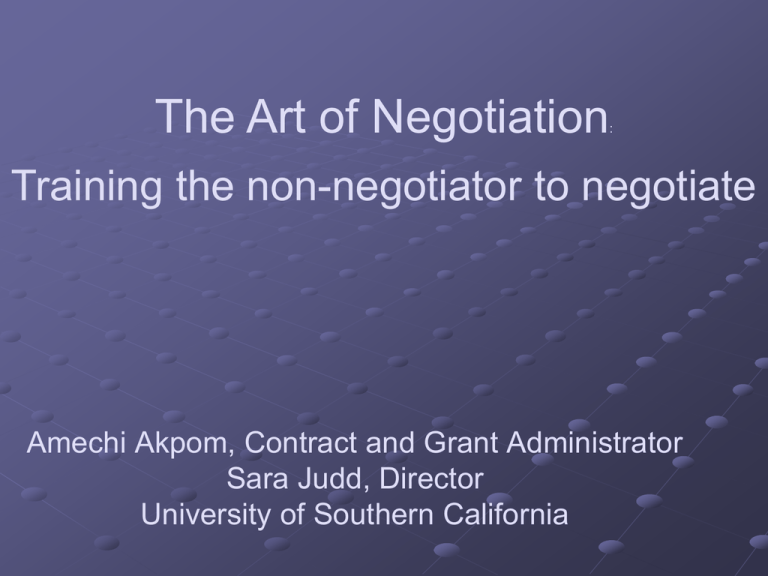
The Art of Negotiation : Training the non-negotiator to negotiate Amechi Akpom, Contract and Grant Administrator Sara Judd, Director University of Southern California Why bother? What’s in it for me/them/the institution? Mitigates risk exposure for University through better language in your agreements It’s a wise investment Builds capacity in your office Builds a valuable resource infrastructure Payoff = Significant reduction in negotiation times & staff effort Examples: Master agreements and templates Streamlines negotiations Getting to Yes… How Do We Get There? How do we teach others to get there? What do you need to know/have to do this “negotiation” thing, anyway? Knowledge Of the project Of the appropriate laws, regulations, policies Of what we can and cannot do Attitude Open mind Tact Patience Sense of humor Skills/tools Identify and anticipate issues Prepare and implement a solid game plan Communicate well Articulate your position persuasively Build rapport/teambuild Problem-solve What is your role as the trainer/mentor? Teach the fundamental concepts The “why’s” Why teach the why’s? Teach that it’s actually “okay” to negotiate with anyone… Teach how to analyze Teach where to go for what Teach preparation Approach, strategery and teambuilding What is your role as the trainer/mentor? (cont’d) Provide tools/resources Teach how to use tools/resources BE a resource Advise, provide feedback Teach what works Be supportive and encouraging Create an environment that engenders “fearless” negotiators Reinforce concepts and implementation Celebrate successes Referrals Issues to understand Negotiating can be scary Not everyone likes to negotiate Not everyone thinks that they can negotiate well They think that the “strategery” only works for you A lack of knowledge increases stress, procrastination and length of negotiation time Negotiation involves a personal style, and everyone needs to develop their own Learning to negotiate well takes time Show and tell is not just for grade school Adult learning requires engagement and incorporation of different learning tools and circumstances Teaching the right perspective Negotiation IS NOT: Mutual sacrifice in order to secure an agreement Giving in Trying to win an argument Gamesmanship Negotiation IS: Problem solving Finding a formula that will maximize the goals of both parties Teambuilding The training plan The Goal: Foster independent negotiators The 5 stages: Tigers: Provide foundational information Wolves: Review everything together Bears: Mentor takes the lead on negotiations, Bears sit in Webelos: Webelos take the lead on negotiations, mentors sit in Eagle Scouts: Independent negotiators only needing assistance with very complex issues *transition time between stages depends on the person - everyone’s different The training plan – where to start? “Basic Training” Start with the foundational concepts re: big issues, i.e., who we are and why we care about IP, Publication, confidentiality, etc. Utilize formal and informal training opportunities Incorporate real language and examples into teaching scenarios Take every opportunity to confirm understanding Provide ideal, specific rationale language Show and tell isn’t just for elementary school anymore The value of seeing/hearing a real life negotiation Negotiation “before” and “after” discussions Rinse and repeat What tools do you need to maximize training? Training plan that outlines expectations Formal and informal training opportunities Resources Laws, regulations, policies, procedures Language and rationale library Contract checklist Agreements Template, master, previous The “let’s call them right now” attitude *Oh no! I don’t have all of this information completed yet! Agreement Review: The Approach Review the agreement and understand the project Do your homework What are the critical questions to ask Isolate the issues Compare with standard language and principles Have we negotiated with the sponsor before? Check: Institutional data sources Other Administrators, campus, mgmnt Other educational institutions Other resources Standards for clauses (your training materials and the rationale library) Institutional standard research agreement Previous agreements that you have negotiated with good language Develop analysis and Rationale Offer to draft language/propose alternate language Redline the document Draft rationale Negotiate Document the file Remember “Every Good Boy Does Fine”….RICRLND Agreement review…breakin’ it down A 5 step process: Step 1: Review and scribble Encourage them to take a stab at it….even if they don’t know Step 2: Discuss Provide the why’s and why not’s (rationale) Step 3: Redline & rationale Review prior to sending Step 4: Review response from other party Discuss strategery Step 5: Sit in on phone negotiations Step 6: Role play Provide specific feedback on the “how’s” of presenting Step 7: Transition to lead negotiations Teaching STRATEGERY… No, it’s not a typo… Teaching Strategery (cont’d) Teach how to determine the best mode of communication Email or telephone Pros & cons of each Criteria to consider Teach how to develop a rapport/teambuild and why it’s important Teach how to set up a “yes” Teach how to overcome objections Role play Teaching Strategery (cont’d) Teach how to drive without actually being at the wheel Need to know your destination to frame conversation Explain the why’s persuasively Help me understand… The good news is… Teach the effectiveness of utilizing extreme examples Real life is always better than fiction Teach the value of positive It’s all how you say it Live observations Teach how to think on your feet Hear it over and over Teach segues Teaching Strategery (cont’d) Teach how to get unstuck Teach to ask for help Ready, Set, Go… Questions??? Answers??? Jokes???


